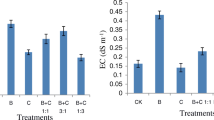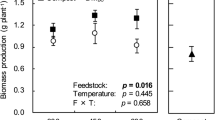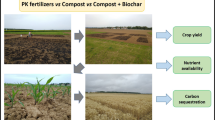Abstract
Mankind is actually facing serious issues due to the overexploitation of fossil fuels, biomass, soils, nitrogen, and phosphorus. It is claimed that biochar addition to soil improves C sequestration to prevent CO2 from atmospheric cycling. Biochar addition should also increase soil fertility in a similar way as anthropogenic dark earths of Central Amazonia. Previous studies have shown that biochar stimulates plant growth and increase fertilizer efficiency, especially when biochar is combined with organic fertilizers such as compost. However, little is known about optimum addition amounts and mixture ratios of biochar and compost. Indeed most experiments to mimic Terra preta de Indio focused on biochar alone or biochar in combination with mineral fertilizers. Therefore, we studied optimum biochar and compost amounts and mixture ratios with respect to plant response and soil fertility. We tested the effect of total amount from 0 to 200 Mg/ha, and biochar proportion from 0 % to 50 % biochar, of 18 different compost mixtures on growth of oat (Avena sativa L.) and soil properties in a fully randomized greenhouse study with sandy and loamy soil substrates. We sampled soil substrates before and after plant growth and analyzed plant growth and yield, total organic carbon (TOC), total nitrogen (TN), mineralized nitrogen (Nmin), soil reaction (pH), and electrical conductivity (EC) applying standard procedures. Results show that biomass production was increased with rising biochar and compost amounts. Oat plant height and seed weight was improved only with rising biochar amounts, but not with compost amounts. This could be explained by increase of total organic C and total N but not by plant-available ammonium and nitrate. The positive influence of composted biochar on plant growth and soil properties suggests that composting is a good way to overcome biochar’s inherent nutrient deficiency, making it a suitable technique helping to refine farm-scale nutrient cycles.





Similar content being viewed by others
References
Atkinson C, Fitzgerald J, Hipps N (2010) Potential mechanisms for achieving agricultural benefits from biochar application to temperate soils: a review. Plant Soil 337(1):1–18. doi:10.1007/s11104-010-0464-5
Barrow CJ (2011) Biochar: potential for countering land degradation and for improving agriculture. Appl Geogr 34:21–28. doi:10.1016/j.apgeog.2011.09.008
Berglund LM, DeLuca TH, Zackrisson O (2004) Activated carbon amendments to soil alters nitrification rates in Scots pine forests. Soil Biol Biochem 36(12):2067–2073. doi:10.1016/j.soilbio.2004.06.005
Brodowski S, John B, Flessa H, Amelung W (2006) Aggregate-occluded black carbon in soil. Eur J Soil Sci 57(4):539–546. doi:10.1111/j.1365-2389.2006.00807.x
DeLuca TH, Nilsson MC, Zackrisson O (2002) Nitrogen mineralization and phenol accumulation along a fire chronosequence in northern Sweden. Oecologia 133(2):206–214. doi:10.1007/s00442-002-1025-2
Fischer D, Glaser B (2012) Synergisms between compost and biochar for sustainable soil amelioration. In: Sunil K, Bharti A (eds) Management of organic waste. InTech, Rijeka, Croatia, pp 167–198. doi:10.5772/31200
Gerzabek MH, Pichlmayer F, Kirchmann H, Haberhauer G (1997) The response of soil organic matter to manure amendments in a long-term experiment at Ultuna, Sweden. Eur J Soil Sci 48(2):273–282. doi:10.1111/j.1365-2389.1997.tb00547.x
Glaser B, Lehmann J, Zech W (2002) Ameliorating physical and chemical properties of highly weathered soils in the tropics with charcoal—a review. Biol Fertil Soils 35:219–230. doi:10.1007/s00374-002-0466-4
Glaser B, Balashov E, Haumaier L, Guggenberger G, Zech W (2000) Black carbon in density fractions of anthropogenic soils of the Brazilian Amazon region. Org Geochem 31:669–678. doi:10.1016/S0146-6380(00)00044-9
Hossain MK, Strezo V, Chan KY, Ziolkowski A, Nelson PF (2011) Influence of pyrolysis temperature on production and nutrient properties of wastewater sludge biochar. J Environ Manag 92(1):223–228. doi:10.1016/j.jenvman.2010.09.008
Jeffery S, Verheijen FGA, van der Velde M, Bastos AC (2011) A quantitative review of the effects of biochar application to soils on crop productivity using meta-analysis. Agric Ecosyst Environ 144(1):175–187. doi:10.1016/j.agee.2011.08.015
Jones DL, Rousk J, Edwards-Jones G, DeLuca TH, Murphy DV (2011) Biochar-mediated changes in soil quality and plant growth in a three year field trial. Soil Biol Biochem. doi:10.1016/j.soilbio.2011.10.012
Kimetu JM, Lehmann J (2010) Stability and stabilisation of biochar and green manure in soil with different organic carbon contents. Soil Research 48(7):577–585. doi:10.1071/SR10036
Kolb S (2007) Understanding the mechanisms by which a manure-based charcoal product affects microbial biomass and activity. Dissertation, University of Wisconsin
Kuzyakov Y, Subbotina I, Chen H, Bogomolova I, Xu X (2009) Black carbon decomposition and incorporation into soil microbial biomass estimated by 14C labeling. Soil Biol Biochem 41(2):210–219. doi:10.1016/j.soilbio.2008.10.016
Lal R (2009) Soil degradation as a reason for inadequate human nutrition. Food Security 1(1):45–57
Lehmann J, Joseph S (eds) (2009) Biochar for environmental management: science and technology. Earthscan Publications Ltd: London, pp. 251–270
Lehmann J, Pereira da Silva J, Steiner C, Nehls T, Zech W, Glaser B (2003) Nutrient availability and leaching in an archaeological Anthrosol and a Ferralsol of the Central Amazon basin: fertilizer, manure and charcoal amendments. Plant Soil 249(2):343–357. doi:10.1023/A:1022833116184
Liang B, Lehmann J, Sohi SP, Thies JE, O’Neill B, Trujillo L et al (2010) Black carbon affects the cycling of non-black carbon in soil. Org Geochem 41(2):206–213. doi:10.1016/j.orggeochem.2009.09.007
Luo Y, Durenkamp M, deNobili M, Lin Q, Brookes PC (2011) Short term soil priming effects and the mineralisation of biochar following its incorporation to soils of different pH. Soil Biol Biochem 43(11):2304–2314. doi:10.1016/j.soilbio.2011.07.020
Lynch D, VoroneyRP WPR (2005) Soil physical properties and organic matter fractions under forages receiving composts, manure or fertilizer. Compost Sci Utilization 13(4):252–261
Mankasingh U, Choi P-C, Ragnarsdottir V (2011) Biochar application in a tropical, agricultural region: A plot scale study in Tamil Nadu, India. Appl Geochem 26(S):218–221. doi:10.1016/j.apgeochem.2011.03.108
Marris E (2006) Putting the carbon back: Black is the new green. Nature 442(7103):624–626. doi:10.1038/442624a
Mehlich A (1984) Mehlich 3 soil test extractant: a modification of Mehlich 2 extractant. Commun Soil Sci Plant Anal 15(12):1409–1416
Nguyen BT, Lehmann J (2009) Black carbon decomposition under varying water regimes. Org Geochem 40:846–853. doi:10.1016/j.orggeochem.2009.05.004
Prost K, Borchard N, Siemens J, Kautz T, Séquaris JM, Möller A, Amelung W (2013) Biochar affected by composting with farmyard manure. J Environ Qual 4:164–172. doi:10.2134/jeq2012.0064
Schulz H, Glaser B (2012) Effects of biochar compared to organic and inorganic fertilizers on soil quality and plant growth in a greenhouse experiment. J Plant Nutr Soil Sci 175:410–422. doi:10.1002/jpln.201100143
Sohi SP, Krull E, Lopez–Capel E, Bol R (2010) A review of biochar and its use and function in soil. Adv Agron 105:47–82. doi:10.1016/S0065-2113(10)05002-9
Spaccini R, Piccolo A, Conte P, Haberhauer G, Gerzabek MH (2002) Increased soil organic carbon sequestration through hydrophobic protection by humic substances. Soil Biol Biochem 34(12):1839–1851. doi:10.1016/S0038-0717(02)00197-9
Steiner C, Teixeira WG, Lehmann J, Nehls T, de Macêdo JLV, Blum WEH, Zech W (2007) Long term effects of manure, charcoal and mineral fertilization on crop production and fertility on a highly weathered Central Amazonian upland soil. Plant Soil 291(1):275–290. doi:10.1007/s11104-007-9193-9
Thun R, Herrmann R, Knickmann E, Hoffmann G (1991) Handbuch der Landwirtschaftlichen Versuchs- und Untersuchungsmethodik (1): A 1.2.2 Die Untersuchung von Böden. Neumann, Radebeul/Berlin
Tryon EH (1948) Effect of charcoal on certain physical, chemical, and biological properties of forest soils. Ecol Monogr 18:81–115
Wardle DA, Nilsson MC, Zackrisson O (2008) Fire-derived charcoal causes loss of forest humus. Science 320(5876):629. doi:10.1126/science.1154960
Waters D, van Zwieten L, Singh BP, Downie A, Cowie AL, Lehmann J (2011) Biochar in soil for climate change mitigation and adaptation. Soil Health Clim Change 29:345–368. doi:10.1007/978-3-642-20256-8_15
Yao Y, Gao B, Inyang M, Zimmerman AR, Cao X, Pullammanappallil P, Yang L (2011) Biochar derived from anaerobically digested sugar beet tailings: characterization and phosphate removal potential. Bioresour Technol 102(10):6273–6278. doi:10.1016/j.biortech.2011.03.006
Acknowledgments
The authors acknowledge the German Ministry for Education and Research (BMBF) for financial support within the coordinated project “Climate protection: CO2 sequestration by use of biomass in a PYREG reactor with steam engine” (01LY0809F). We are indebted to Daniel Fischer, Georg Lemmer, Ananda Erben, and Bianca and Katharina Karnstedt for the help in the greenhouse and with soil analyses.
Author information
Authors and Affiliations
Corresponding author
About this article
Cite this article
Schulz, H., Dunst, G. & Glaser, B. Positive effects of composted biochar on plant growth and soil fertility. Agron. Sustain. Dev. 33, 817–827 (2013). https://doi.org/10.1007/s13593-013-0150-0
Accepted:
Published:
Issue Date:
DOI: https://doi.org/10.1007/s13593-013-0150-0




